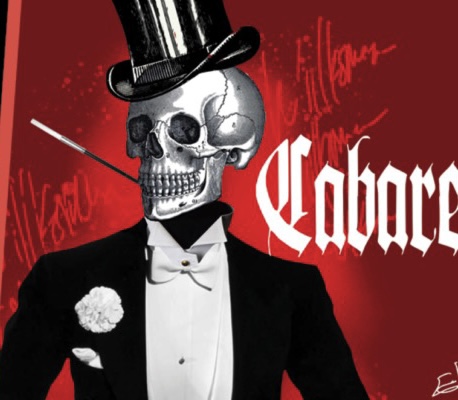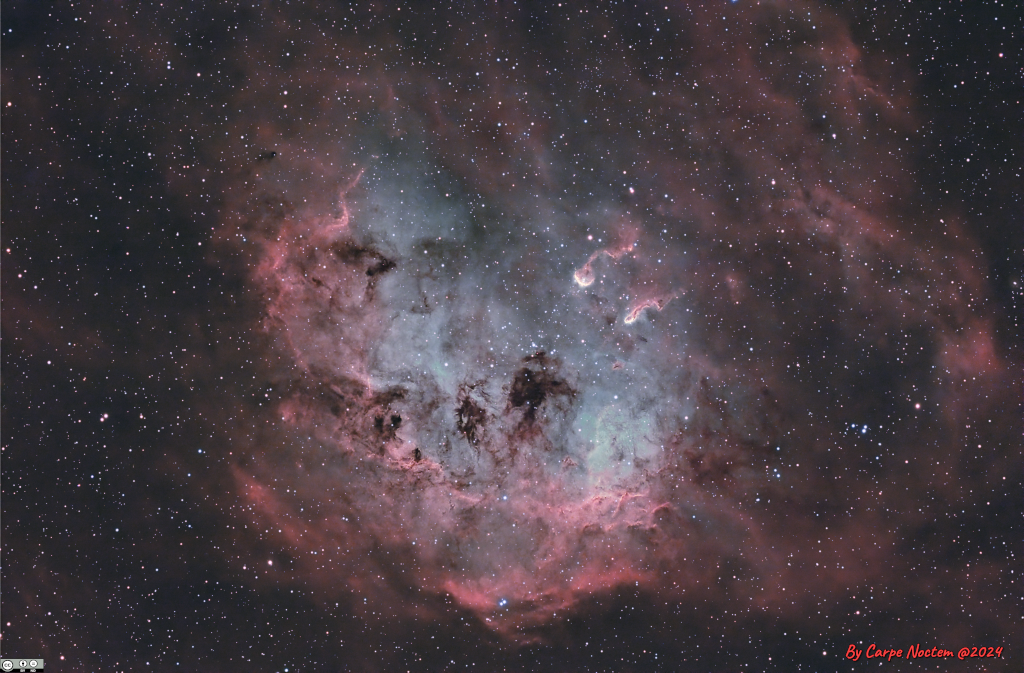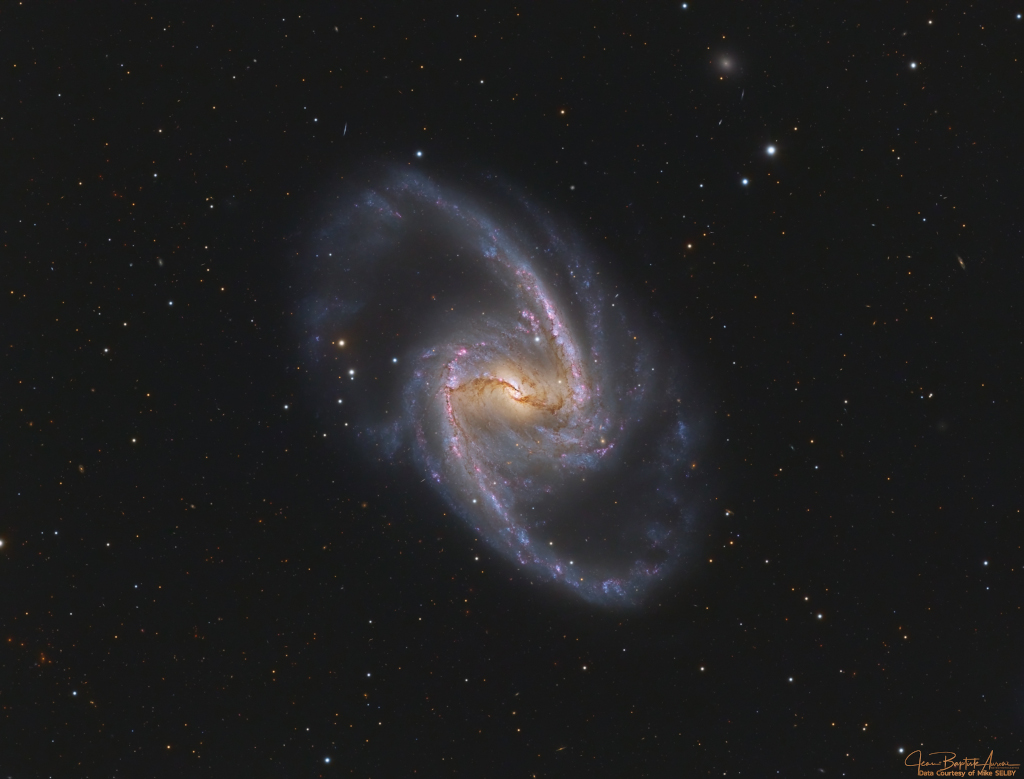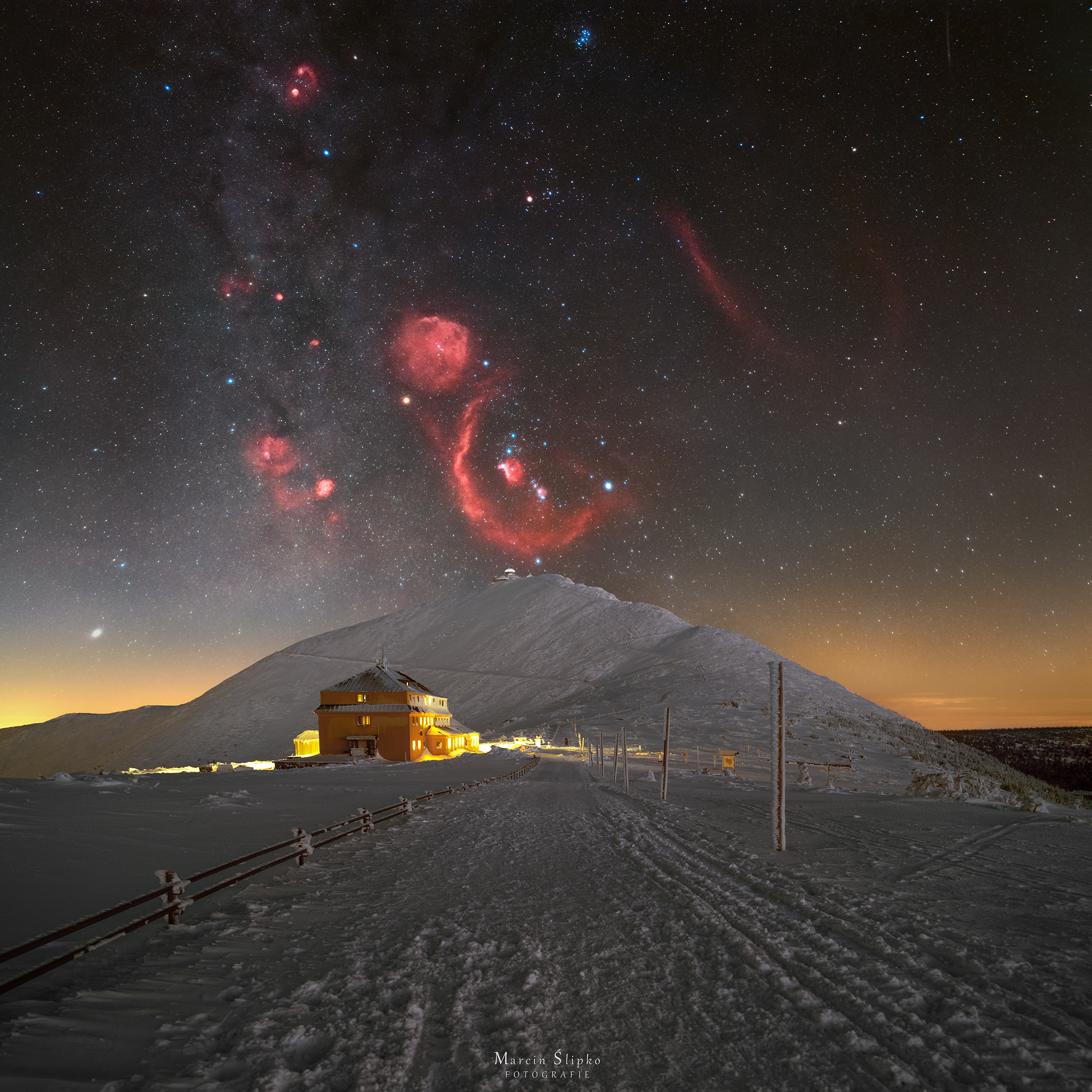Cabaret the Musical at the Mixed Blood Theater by Theatre 55 Friday February 2nd thru February 10th only 7 shows. Art returning to the West Bank. Music with Shirley Mier, Lyra Olson, Jeff Ruhnke, Brian Handeland, Bebe Keith and mick “bamboula” laBriola!

This cosmic view shows off an otherwise faint emission nebula IC 410, captured under clear Netherlands skies with telescope and narrowband filters. Above and right of center you can spot two remarkable inhabitants of the interstellar pond of gas and dust, known as the tadpoles of IC 410. Partly obscured by foreground dust, the nebula itself surrounds NGC 1893, a young galactic cluster of stars. Formed in the interstellar cloud a mere 4 million years ago, the intensely hot, bright cluster stars energize the glowing gas. Globules composed of denser cooler gas and dust, the tadpoles are around 10 light-years long and are likely sites of ongoing star formation. Sculpted by stellar winds and radiation their heads are outlined by bright ridges of ionized gas while their tails trail away from the cluster’s central young stars. IC 410 and embedded NGC 1893 lie some 10,000 light-years away, toward the nebula-rich constellation Auriga.

see full post...
Graham William Nash OBE (born 2 February 1942) is an English-American musician, singer and songwriter. He is known for his light tenor voice and for his contributions as a member of the Hollies and Crosby, Stills & Nash.
Nash is a photography collector and a published photographer. He was inducted into the Rock and Roll Hall of Fame as a member of Crosby, Stills & Nash in 1997 and as a member of the Hollies in 2010. He was appointed an Officer of the Order of the British Empire (OBE) in the 2010 Birthday Honours List for services to music and to charity.
Nash holds four honorary doctorates, including one from the New York Institute of Technology, one in music from the University of Salford in 2011 and one in fine arts from Lesley University in Cambridge, Massachusetts.
see full post...
Stan Getz (born Stanley Gayetski, February 2, 1927 – June 6, 1991) was an American jazz saxophonist. Playing primarily the tenor saxophone, Getz was known as “The Sound” because of his warm, lyrical tone, with his prime influence being the wispy, mellow timbre of his idol, Lester Young. Coming to prominence in the late 1940s with Woody Herman‘s big band, Getz is described by critic Scott Yanow as “one of the all-time great tenor saxophonists”. Getz performed in bebop and cool jazz groups. Influenced by João Gilberto and Antônio Carlos Jobim, he also helped popularize bossa nova in the United States with the hit 1964 single “The Girl from Ipanema“.
Stan Getz was born Stanley Gayetski on February 2, 1927, at St. Vincent’s Hospital in Philadelphia, Pennsylvania, United States. Getz’s father Alexander (“Al”) was a Ukrainian Jewish immigrant who was born in Mile End, London, in 1904, while his mother Goldie (née Yampolsky) was born in Philadelphia in 1907. His paternal grandparents Harris and Beckie Gayetski were originally from Kyiv, Ukraine, but had migrated to escape the anti-Jewish pogroms to Whitechapel, in the East End of London. While in England they owned the Harris Tailor Shop at 52 Oxford Street for more than 13 years. In 1913, Harris and Beckie emigrated to the United States with their three sons Al, Phil, and Ben, following their son Louis Gayetski who had emigrated to the US the year before. Getz’s original family name, “Gayetski”, was changed to Getz upon arrival in America.
https://www.youtube.com/watch?v=M3v7u1OmHZE&list=PL0q2VleZJVEkjEVGqDGrLdj0iHZQ_pAJG&index=7
see full post...Sonny Stitt (born Edward Hammond Boatner Jr.; February 2, 1924 – July 22, 1982) was an American jazz saxophonist of the bebop/hard bop idiom. Known for his warm tone, he was one of the best-documented saxophonists of his generation, recording more than 100 albums. He was nicknamed the “Lone Wolf” by jazz critic Dan Morgenstern because of his tendency to rarely work with the same musicians for long despite his relentless touring and devotion to jazz. Stitt was sometimes viewed as a Charlie Parker mimic, especially earlier in his career, but gradually came to develop his own sound and style, particularly when performing on tenor saxophone and even occasionally baritone saxophone.
Edward Hammond Boatner, Jr. was born in Boston, Massachusetts, and grew up in Saginaw, Michigan. He had a musical background: his father, Edward Boatner, was a baritone singer, composer, and college music professor; his brother was a classically trained pianist, and his mother was a piano teacher. He was placed for adoption in 1924 by his father and adopted by the Stitt family in Saginaw. He later began calling himself “Sonny”. While in high school in Saginaw, he played in the Len Francke Band, a local popular swing band.
In 1943, Stitt met Charlie Parker. As he often recalled, the two men had similar styles. Parker is alleged to have remarked, “Well, I’ll be damned, you sound just like me”, to which Stitt responded, “Well, I can’t help the way I sound. It’s the only way I know how to play.” Kenny Clarke said of Stitt, “Even if there had not been a Bird, there would have been a Sonny Stitt.
see full post...A Gitano-derived word, ‘Bulerias’ comes from the Spanish word ‘buleria,’ which means ‘torn-foolery’ or ‘ridicule.’ Many theories abound on its roots. A recent development of the Cante Gitano, it appears to be barely a century old. Still associated with the Gitanos, Bulerias is a toque with enormous flexibility, ever-evolving in style. Some like to call it ‘omnivorous,’ since much music from other genres, namely pop songs, even non-Spanish music, has been set to its compas. Often dances, including Soleares, Alegrias, and other toques, end with a flourish by introducing Bulerias at the climax.
see full post...Barred spiral galaxy NGC 1365 is truly a majestic island universe some 200,000 light-years across. Located a mere 60 million light-years away toward the faint but heated constellation Fornax, NGC 1365 is a dominant member of the well-studied Fornax Cluster of galaxies. This sharp color image shows the intense, reddish star forming regions near the ends of the galaxy’s central bar and along its spiral arms. Seen in fine detail, obscuring dust lanes cut across the galaxy’s bright core. At the core lies a supermassive black hole. Astronomers think NGC 1365’s prominent bar plays a crucial role in the galaxy’s evolution, drawing gas and dust into a star-forming maelstrom and ultimately feeding material into the central black hole.

see full post...
Joseph Leslie Sample (February 1, 1939– September 12, 2014 Houston, TX) was an American jazz keyboardist and composer. He was one of the founding members of The Jazz Crusaders in 1960, the band which shortened its name to “The Crusaders” in 1971. He remained a part of the group until its final album in 1991 and also the 2003 reunion album Rural Renewal.
Beginning in the late 1960s, he enjoyed a successful solo career and guested on many recordings by other performers and groups, including Miles Davis, George Benson, Jimmy Witherspoon, Michael Franks, B. B. King, Eric Clapton, Steely Dan, Joni Mitchell, Anita Baker, and the Supremes. Sample incorporated gospel, blues, jazz, latin, and classical forms into his music.
see full post...Sadao Watanabe (渡辺 貞夫, Watanabe Sadao, born 1 February 1933) is a Japanese jazz musician who plays alto saxophone and sopranino saxophone. He is known for his bossa nova recordings, although his work encompasses many styles, with collaborations from musicians all over the world.
Watanabe was born on 1 February 1933 in Utsunomiya, Japan. His father, a professional musician, sang and played the biwa. Watanabe was attracted to jazz from an early age, in part due to the strong cultural influence stemming from the American post-war presence in Japan. He learned the clarinet while in high school after convincing his father over the course of six weeks to buy him a second-hand instrument.
In 1951, Watanabe moved to Tokyo and began playing the alto saxophone. He started studying the flute in 1953 with Ririko Hayashi from the Tokyo Philharmonic Orchestra. Watanabe joined Toshiko Akiyoshi‘s Cozy Quartet and began leading the group when Akiyoshi moved to the USA.[1] By 1958, Watanabe had performed with leading musicians and quartets. In 1961, his first album as a leader, the self-titled Sadao Watanabe, was released.
see full post...Joe “Tricky Sam” Nanton (February 1, 1904 – July 20, 1946) was an American trombonist with the Duke Ellington Orchestra. A pioneer of the plunger mute, Nanton is notable for his use of the distinctive wah-waheffect.
He was born Joseph Irish Nanton in New York City, United States. His parents were John Barzly Nanton and Emily Irish, both immigrants from the British West Indies.
Nanton began playing professionally in Washington, D.C., with bands led by Cliff Jackson and banjoist Elmer Snowden.
From 1923 to 1924, Nanton worked with Frazier’s Harmony Five. A year later, he performed with Snowden. At the age of 22, Nanton found his niche in Duke Ellington’s Orchestra, when he reluctantly took the place of his friend Charlie Irvis in 1926, and remained with Ellington until his early death in 1946. Nanton, along with Lawrence Brown, anchored the trombone section.
see full post...James Mercer Langston Hughes (February 1, 1901 – May 22, 1967) was an American poet, social activist, novelist, playwright, and columnist from Joplin, Missouri. One of the earliest innovators of the literary art form called jazz poetry, Hughes is best known as a leader of the Harlem Renaissance. He famously wrote about the period that “the Negro was in vogue”, which was later paraphrased as “when Harlem was in vogue.”
Growing up in a series of Midwestern towns, Hughes became a prolific writer at an early age. He moved to New York City as a young man, where he made his career. He graduated from high school in Cleveland, Ohio, and soon began studies at Columbia University in New York City. Although he dropped out, he gained notice from New York publishers, first in The Crisis magazine and then from book publishers, and became known in the creative community in Harlem. He eventually graduated from Lincoln University. In addition to poetry, Hughes wrote plays and short stories. He also published several nonfiction works. From 1942 to 1962, as the civil rights movement gained traction, he wrote an in-depth weekly column in a leading black newspaper, The Chicago Defender.
see full post...The famous constellation is visible to the southeast just after sunset. From most Earthly locations, Orion’s familiar star pattern, highlighted by the three-stars-in-a-row belt stars, rises sideways. An entire section of the night sky that includes Orion was photographed rising above Śnieżka, a mountain on the border between Poland and the Czech Republic. The long duration exposure sequence brings up many faint features including the Orion and Flame Nebulas, both encompassed by the curving Barnard’s Loop. The featured wide-angle camera composite also captured night sky icons including the blue Pleiades star cluster at the image top and the red Rosette Nebula to the left of Orion. Famous stars in the frame include Sirius, Betelgeuse, Rigel and Aldebaran. Orion will appear successively higher in the sky at sunset during the coming months.

see full post...
Franz Peter Schubert ; 31 January 1797 – 19 November 1828) was an Austrian composer of the late Classical and early Romantic eras. Despite his short life, Schubert left behind a vast oeuvre, including more than 600 secular vocal works (mainly lieder), seven complete symphonies, sacred music, operas, incidental music, and a large body of piano and chamber music. His major works include the art songs Erlkönig, Gretchen am Spinnrade, Ave Maria; the Trout Quintet, the unfinished Symphony No. 8 in B minor, the “Great” Symphony No. 9 in C major, the String Quartet No. 14 “Death and the Maiden”, a String Quintet, the two sets of Impromptus for solo piano, the three last piano sonatas, the Fantasia in F minor for piano four hands, the opera Fierrabras, the incidental music to the play Rosamunde, and the song cycles Die schöne Müllerin, Winterreise and Schwanengesang.
Born in the Himmelpfortgrund suburb of Vienna, Schubert showed uncommon gifts for music from an early age. His father gave him his first violin lessons and his elder brother gave him piano lessons, but Schubert soon exceeded their abilities. In 1808, at the age of eleven, he became a pupil at the Stadtkonvikt school, where he became acquainted with the orchestral music of Joseph Haydn, Wolfgang Amadeus Mozart, and Ludwig van Beethoven. He left the Stadtkonvikt at the end of 1813 and returned home to live with his father, where he began studying to become a schoolteacher. Despite this, he continued his studies in composition with Antonio Salieri and still composed prolifically. In 1821, Schubert was admitted to the Gesellschaft der Musikfreunde as a performing member, which helped establish his name among the Viennese citizenry. He gave a concert of his works to critical acclaim in March 1828, the only time he did so in his career. He died eight months later at the age of 31, the cause officially attributed to typhoid fever, but believed by some historians to be syphilis.
Appreciation of Schubert’s music while he was alive was limited to a relatively small circle of admirers in Vienna, but interest in his work increased greatly in the decades following his death. Felix Mendelssohn, Robert Schumann, Franz Liszt, Johannes Brahms and other 19th-century composers discovered and championed his works. Today, Schubert is ranked among the greatest composers in the history of Western classical music and his work continues to be admired and widely performed.
see full post...
Charles Douglas Musselwhite (born January 31, 1944) is an American blues harmonica player and bandleader, one who came to prominence, along with Mike Bloomfield, Paul Butterfield, and Elvin Bishop, as a pivotal figure in helping to revive the Chicago Blues movement of the 1960s. He has often been identified as a “white bluesman”. Musselwhite was reportedly the inspiration for Elwood Blues; the character played by Dan Aykroyd in the 1980 film, The Blues Brothers.
Musselwhite, whose father and paternal grandfather were also named Charlie Musselwhite (making him Charlie Musselwhite III), was born in Kosciusko, Mississippi to white parents. Originally claiming to be of partly Choctaw descent, in a 2005 interview he said his mother had told him he was of distant Cherokee descent. His family considered it natural to play music. His father played guitar and harmonica, his mother played piano, and a relative was a one-man band.
see full post...Philip Glass (born January 31, 1937 Baltimore, MD) is an American composer and pianist. He is widely regarded as one of the most influential composers of the late 20th century. Glass’s work has been associated with minimalism, being built up from repetitive phrases and shifting layers. Glass describes himself as a composer of “music with repetitive structures”, which he has helped to evolve stylistically.
Glass founded the Philip Glass Ensemble, which is still in existence, but Glass no longer performs with the ensemble. He has written fifteen operas, numerous chamber operas and musical theatre works, fourteen symphonies, twelve concertos, nine string quartets, various other chamber music pieces, and many film scores. Three of his film scores have been nominated for Academy Awards.
see full post...Roosevelt Sykes (January 31, 1906 – July 17, 1983) was an American blues musician, also known as “the Honeydripper“. Sykes was born the son of a musician in Elmar, Arkansas. “Just a little old sawmill town”, Sykes said of his birthplace. The Sykes family was living in St. Louis by 1909. Sykes often visited his grandfather’s farm near West Helena. He began playing the church organ around the age of ten. “Every summer I would go down to Helena to visit my grandfather on his farm,” he told biographer Valerie Wilmer. “He was a preacher and he had an organ I used to practice on, trying to learn how to play. I always liked the sound of the blues, liked to hear people singing, and since I was singing first, I was trying to play like I sang.” Sykes was baptized at 13 years old, his lifelong beliefs never conflicting with playing the blues.
see full post...